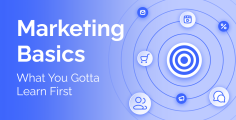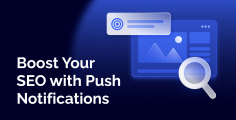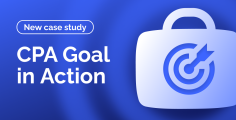Cognitive bias is a mental shortcut, enabling people to act fast when needed. Cognitive biases can be used to win the audience’s favor. How come? Well… they are rooted deeply in the subconscious, meaning if you can harness their power, the user will not even understand why they want to buy from you. This can work in any vertical, as long the potential audience consists of humans.
At the same time, cognitive biases can hamper your progress as a marketer. Thus, it’s crucial to learn more about them and resist their effects accordingly.
Read on to learn more about the details of how 10 of some of the most popular biases work. You will also find explanations why A/B testing is crucial, based on cognitive biases.
Cognitive Bias Explained
Cognitive bias is a mental shortcut, enabling us to act quickly and without thinking. This helps conserve energy and achieve more goals but can lead to suboptimal conclusions and decisions.
Cognitive bias is akin to an optical illusion: you need a ruler or angle change to dispel the illusion. But even if you know the trick, it doesn’t mean you’re safe from its effects. Fortunately, the same principle applies to your target audience.
Thus, as a marketer, you need to understand the most common biases and how you can leverage them. At the same time, it’s wise to know about them, so that you can resist their influence better.
List of the Most Common Biases
We’ve prepared a list of cognitive biases and how you can use them in your campaigns. Pick the one you like and let the exploration begin.
And once you’re done exploring, make sure to put your recently obtained knowledge into practice. Register on RollerAds to launch a campaign and squeeze the most out of Push notifications and OnClicks.
Anchoring
The order in which we receive information affects our judgment. The first point of contact proves to be the anchoring point, against which all the comparisons are made.
How to Use
When making pre-landers, you can integrate a comparison of prices for eCommerce offers. Now, you can either present the most lucrative offer first, so that the user eventually comes back for it. Or you can begin with an overpriced (fake) item to ensure your actual offer, which follows, will be perceived better.
Via: Freepik
Figuring out which approach drives more conversions sounds like a solid reason for A/B testing.
Door in Your Face
The so-called “door-in-your-face” capitalizes on following an inadequate request with a reasonable offer. The initial request creates a sense of obligation, which the counter-party cannot fulfill. The proceeding query eases the tension, enabling the other party to fulfill their “duty”, which is good for improving overall compliance.
How to Use
People don’t feel easy saying no all the time, so the 2nd request seems like no big deal. This is because it was properly framed and the Overton window shifted (we’ll get to these biases a bit later).
And if you’re wondering why it’s called “door in your face”, it’s because the initial rejection serves as a metaphorical door, which has been closed. For example, a user might not be OK with buying Nutra pills for $500. But they are more likely to accept the same pills for $100, even though they normally cost $50.
Framing Effect
Via: Freepik
Delivery, package, framing, context, etc. all influence our perception. That’s why the advertising industry exists in the first place, the affiliate marketing branch included.
People tend to be risk-seeking when maximizing gains and risk-averse when minimizing losses. This underlying principle of human behavior creates a chance to improve your sales just by paraphrasing some CTAs and product descriptions.
How to Use
Imagine you’re an affiliate marketer promoting a fitness product, specifically a protein supplement. The product consists of two ingredients: 90% protein content and 10% fat.
Capitalize on the 90% protein side of the product and label it as “High-Protein Powerhouse” or “Optimal Muscle Building Formula”. Emphasize its high protein content and how it can help users gain lean muscle mass efficiently to ensure people perceive your product better.
If you’d rather prefer to appeal to risk-averse people, position the 90% protein content as a positive aspect but emphasize how the low-fat content minimizes potential health risks associated with consuming protein supplements.
Overton Window
Via: Reformed Perspective
Overton window is a political concept, describing shifting normality, but it can be applied to other spheres of our lives too, affiliate marketing included. It describes and shapes simultaneously public opinion on specific topics.
Overton window has some boundaries of acceptance, which can be influenced, making unthinkable ideas possible. For example, the Roman Empire’s economy was based on slavery, which is something unimaginable nowadays.
How to Use
You engage in a mini-Overton window whenever making a marketing funnel. Specifically, you try to hook the users and persuade them that your offer will solve their problems. But unlike politicians, you have a shorter timespan for persuasion.
Overton window is a two-way street, influencing marketers as well. Being able to locate trendy products, i.e., within the boundaries of the Overton window, is a gold mine, since people are guaranteed to perceive such goods better on average.
For instance, market eco-friendly household products to appeal to the growing concern for sustainability. Emphasize their positive impact on the environment and create urgency by framing them as solutions to pressing global issues like plastic pollution. Stay authentic to avoid greenwashing and contribute to expanding the acceptance of eco-friendly practices.
Negativity Bias
People are risk-averse by nature. Thus, negative events tend to have a bigger impact on our judgment, compared to similar positive events of the same degree. For example, losing $100 hurts more than winning the same sum.
Being unchecked, this bias can kill solid hypotheses, simply because you’re afraid to press on. That’s another argument in favor of running A/B tests: they are perfectly unbiased, provided the setup is right. It might be challenging to accept the results, but it’s better than wrapping oneself up in sweet little lies.
Via: Freepik
How to Use
Leverage the negativity bias by highlighting the potential negative consequences of not taking action, such as financial loss or insecurity. Position your product or service as a solution to these pain points, emphasizing how it can help users avoid common pitfalls and achieve better outcomes. Use social proof and limited-time offers to create urgency and motivate action.
Availability Heuristic
We tend to judge the likelihood of something, based on how easily we can recall it. Personal experience prevails over objective facts. But just because your college friend was robbed doesn’t make students the #1 target for robbers.
How to Use
That’s a huge problem when making important decisions without data. While this mental shortcut might work in some instances (don’t go to dilapidated neighborhoods at night with a shiny briefcase), more often than not this prior experience clouds our judgment.
On the other hand, if you manage to tap into the user’s past experience and provide evidence to support it, the user is likely to begin trusting you. That’s how astrology works.
Barnum Effect
Speaking of astrology, the Barnum effect occurs when we see personal specifics in vague statements. This is the golden goose of all fortune-tellers, astrologists, and other mystics. Our brains are wired to see connections, thus it’s easy for us to fill in all the gaps and start seeing non-existing things.
How to Use
Counter it by asking yourself: “Can it be applied to another person as well?” or “Am I the only one that smart?”.
Or use it to your advantage and utilize such hooks that resonate with a broader audience. One good example is being not like everybody else — probably every person has ever said this to themselves at least once in their life. Try capitalizing on this idea and invite “not-like-everybody-else” users to try out your new offer. As L’Oréal puts it: “because you’re worth it”.
Miscellaneous Biases to Account For
These biases are not always directly related to marketing, but they can affect your work in a media buying team. They also highlight the importance of A/B testing, so if you’ve been struggling with understanding why it matters — read on.
Group Thinking
Group thinking is also known as the wisdom of the crowd (positive) or herd instinct (negative). It all boils down to conformity vs. critical and creative thinking. When in groups, people are prone to confirm with the group, in order not to risk being humiliated.
This is especially dangerous for companies, networks, and media buying teams, as members might be afraid to seek the truth and ask questions in order not to get ostracized.
As a leader, encourage people to start talking and share their ideas. Then, find some good points, e.g., being daring enough to stand up for oneself. Afterward, follow it up with “things for improvement”. Don’t say “bad points” because, as discussed above, framing alone can make all the difference when it comes to sales, presentations, and daily communication.
You can also capitalize on group thinking and encourage people to spread the positive word about your product on social media in exchange for some freebies. This is a great way to drive some redirect and organic traffic to your pre-landers and landing pages. But be careful not to generate negative reviews and leave them unattended, as they create a negative first impression, which is hard to overcome.
An alternative way to take advantage of this bias is to add social proof elements to your pre-landers, so the arriving users see the feedback from their peers. People tend to trust their peers more than any company, due to an inherent power distance and subsequent alienation.
Another tried and true way to drive more traffic for your needs is to sign up for RollerAds and enjoy flexible targeting settings, traffic presets, quality-of-life features, and much more.
Confirmation Bias
Your existing beliefs prevail over the new info. Basically, people look for ways to justify everything they believe in. Thus, people perceive better what they believe in. That’s why it’s so important to know your audience.
Moreover, due to this bias, people can barely judge objectively — that’s where A/B testing saves the day. Your hunch can fail you, only because it is usually grounded in previous experience, which does not always remain correct. Split-testing, on the other hand, deals with objective data, helping you to understand what the users actually want, no matter what you feel toward such a trend.
Backfire Effect
However, don’t rush to influence other people and challenge their beliefs, based on the idea of Overton window, as it might backfire. People are reluctant to changes and prefer the status quo. When our beliefs are challenged, we are inclined to believe them even stronger.
When you try to sell something, it’s best to understand your target audience as much as you can, so you can recognize their preferences and cater to their beliefs. It’s just easier to adapt instead of changing the users.
But if you want to understand how to prevent yourself from falling victim to this bias, consider your beliefs as software. You use such programs to solve problems at hand and not to defend something with a passion of zealot.
False ideas, like “Pushes are dead” can lead to a high cost of opportunity. Don’t fool yourself and let RollerAds reassure you. Sign up for our platform, try out our ad formats in practice, and observe how Pushes boost your profits.
Conclusion
Cognitive biases are like shortcuts our brains take to process information quickly, but they don’t always lead to the best decisions. While they can help marketers understand and influence consumer behavior, they also pose risks of leading to flawed judgments.
Cognitive biases help to bypass user’s objections, much like our Push notifications bypass ad blockers. Knowing how to leverage them raises your chances of firing a conversion and delivering the product that the users crave subconsciously.
Long story short, cognitive bias is a double-edged sword, which has helped us to evolve. It can work both in your favor and against you, which is why you’re better off knowing as much as possible about it to protect yourself and resonate with the audience better.





